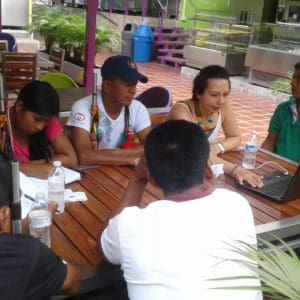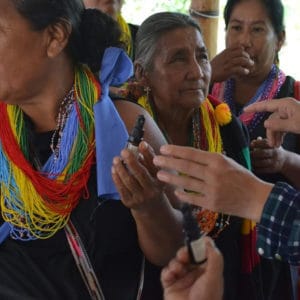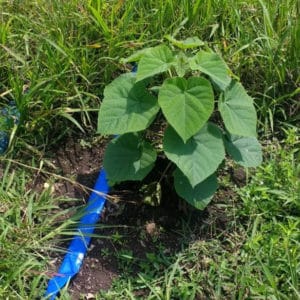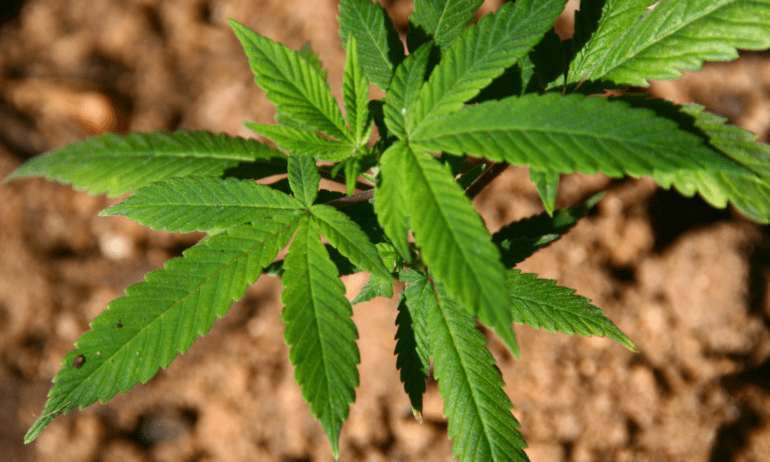Photographs courtesy of Dr. Latorre.
New York’s Arachna-med and Colombia’s La Finca Interacviva promote sustainable and socially inclusive agricultural practices among the indigenous peoples of Colombia. As a joint-venture advocacy, research, and support organization, they strive to help reduce the production and consumption of illegal drugs such as cocaine and heroin, and focus on the health benefits of medical marijuana.
Historically, medical and recreational use of marijuana has been a controversial global issue. Under the Controlled Substance Act of 1970, the United States classifies marijuana or cannabis as Scheduled I drugs—drugs with no currently accepted medical use with high potential for abuse—while countries such as Colombia have seen the negative impacts of the production of illegal crops such as drug trafficking.
However, various states in the U.S are now permitting the use of marijuana for medical and recreational purposes. Similarly, a peace treaty signed between the rebel groups and Colombian government hopes to address the illegal drug production issues, among many other issues, according to La Finca Interacviva’s founder, Dr. Rafael Latorre.
Food Tank had the opportunity to talk with Latorre, a Colombian-American physician, about the connections between the production of illegal crops, environmental conservation, poverty, and social exclusion of the indigenous people of Colombia.
Food Tank (FT): Could you tell us about your career as a physician in the United States, and your involvement as both an advocate for sustainable agriculture and a farmer in Palmira, Colombia?
Dr. Rafael Latorre (RL): Growing up in Colombia, I love nature and agriculture, and briefly considered pursuing a career as a farmer. Realizing the lack of professional career choices in that field, I instead became a medical doctor.
In 1990, I arrived in New York to attend the Internal Medicine and Geriatrics program at the Albert Einstein School of Medicine. After graduating, I established a medical practice in New Jersey, primarily serving immigrants from Latin America and hiring Spanish-speaking nurses, aids, and secretaries. Most of my patients there hadn’t seen a doctor in years, and I created a network of physicians willing to treat these individuals at a very low cost or, sometimes, no cost at all. Our patients began bringing their friends and family in for treatment, forcing us to hire more physicians and office personnel, therefore, growing the practice tremendously.
Affiliated with both Hackensack University Hospital and Englewood Hospital, the office became a teaching site for The New Jersey School of Medicine’s medical students. I recently stepped down as medical Director there to pursue other interests, such as international medical missions for charity and farming.
 After becoming a successful physician, I combined my medical career with my father’s old dream and started farming. This first-hand exposure to farming gave me an insight into a world unbeknownst to me, allowing me to understand the intimate relationship between soil, plants, animals, and humans. I realized the importance of balance within the food system; food scarcity leads to a low state of immunity, low intelligence, and infection, while food excess leads to metabolic illness and obesity, diabetes, and premature death. No one should be left without access to nutritious food or a healthy environment.
After becoming a successful physician, I combined my medical career with my father’s old dream and started farming. This first-hand exposure to farming gave me an insight into a world unbeknownst to me, allowing me to understand the intimate relationship between soil, plants, animals, and humans. I realized the importance of balance within the food system; food scarcity leads to a low state of immunity, low intelligence, and infection, while food excess leads to metabolic illness and obesity, diabetes, and premature death. No one should be left without access to nutritious food or a healthy environment.
FT: La Finca Interacviva hopes to lead the way for medical marijuana through activism, support for a strong regulatory framework, and a more inclusive and participatory business model for the indigenous people and farmers. Could you elaborate on your efforts?
RL: I realized that in Colombia, as in most of Latin America, those working the land and producing food are usually paid below the established legal minimum wage, lacking access to medical services and retirement benefits. They live in poverty-stricken communities with little possibilities to make a dignified living, unable to access the developing economies around them. This forces poor farmers to produce illegal crops in Colombia and other regions, including Afghanistan, India, and Iraq, just so they can feed their families.
These realities motivated me to find a solution to some of the problems indigenous and small farmers in Colombia face today. The core offerings of our plan are:
1) Offer a legal crop, regulated by the Colombian government, that affords real possibilities of economic prosperity, creating a sense of belonging to a society these farmers have felt excluded from for generations. 2) Stop deforestation while promoting environmental conservation and techniques that protect biodiversity, soil, and water, and keep local resources thriving. 3) Keep communities cohesive by increasing their production on their ancestral lands and discouraging migration to big cities in search of low-paid and low-skilled jobs. After more than 50 years of conflict, many institutions, NGOs, commissions, analysts, and observers from Colombia—and many countries around the world—have concluded that the root problem of the Colombian conflict is primarily inequality, exclusion, and lack of opportunities.
La Finca Interacviva’s foundation for a sustainable, environmentally responsible, and economically viable enterprise is based on the inclusion of those communities historically excluded from participating in a developing economy. Our model is based on partnering with indigenous and small farmers to mentor and help them develop prosperous small family units, affording them a dignified life within the boundaries of legality and allowing for true social participation.
FT: How are the indigenous communities involved in the production and impacted by illegal crop production from socio-economic standpoint?
 RL: There are close to 400 million indigenous peoples in the world today, most of them living below the poverty line. Their land comprises close to 30 percent of the entire world’s land, and 70 percent of the world’s entire biodiversity is in these territories. They are an integral part of our subsistence and are the world’s ecosystem protectors.
RL: There are close to 400 million indigenous peoples in the world today, most of them living below the poverty line. Their land comprises close to 30 percent of the entire world’s land, and 70 percent of the world’s entire biodiversity is in these territories. They are an integral part of our subsistence and are the world’s ecosystem protectors.
Colombia has around 180,000 hectares of coca plantations, according to the latest U.S. Drug Enforcement Administration reports. The world’s illegal trade is a US$50 billion per year business, and 48 percent of it is from Colombian illegal crops. But, shockingly, just a handful of dollars from this multi-billion dollar business stays in these communities, leaving behind only poverty, violence, analphabetism, despair, and humiliation.
Some members of these communities are joining the Association of Small Growers of Medical Cannabis in Colombia, a nonprofit organization. People involved with illegal crops must start a new plot, register it with the justice department, and obtain a growing license which qualifies them for the Crop Substitution Program currently being offered by the Colombian government. This program provides economic incentives to help those farmers willing to transition into legal crops.
La Finca Interacviva, in conjunction with the Association of Small Growers of Medical Cannabis, will guide those interested in becoming part of our program. It will supply them with seed, training, technical advice, and other requirements established by various branches of the government, from day one. Training includes the implementation of good practices as specified by U.N. Food and Agriculture Organization. The Association will purchase the crops from each one of its member farmers. We have already signed an agreement with an indigenous community in Cauca with more than 2,000 families as members. A pilot program to start developing the first round of plots will begin within weeks. The documents to apply for the licenses are being gathered right now.
FT: Could you explain the connections between illegal crop production, rights of the indigenous people and impoverished farming communities, and erosion of natural resources such as deforestation in the Colombian Rainforests?
RL: The indigenous peoples territories have a different legislation from the rest of the country (similar to that differentiation in the U.S.) where coca and marijuana trees are considered ancestral crops within their lands. Indigenous peoples of America have been using these plants since pre-Hispanic times, as recorded by historians for centuries. Precisely with the invention of cocaine, their crops grew exponentially as demand increased. They became coca leaves suppliers to the cocaine trade and massive deforestation began in order to expand the plantations, destroying entire habitats.
Coca leaves were used for centuries as food and medicine, it was the tobacco of the highlands and was used as currency in exchange for fruits and fish from the lowlands. It served its purpose as a natural stimulant that allowed them to work and live in the high-altitude places. Machu Picchu, one of the world marvels, would not exist if it wasn’t for its builders’ use of coca leaves. And this incredible plant was demonized in the 1900s after Friedrich Gaedcke, a European chemist, isolated the highly addictive alkaloid cocaine, rendering the plant illegal. These peasants have remained poor and exploited, barely making a modest living. Our proposal is truly a realistic opportunity to change the lives of hundreds of thousands of families across Co lombia and a good start to initiate a downward curve of the illegal drug markets.
lombia and a good start to initiate a downward curve of the illegal drug markets.
As a member of the civil society and a member of the U.N. NGO Committee for the Rights of Indigenous Peoples, I am advocating for their right to their lands, deculturalization prevention, and preservation of their ancestral knowledge of nature and ethnobotanicals as well as their languages. Most of their dialects don’t have a written form, so their knowledge travels from generation to generation in spoken form and forced deculturalization, from western pressures, is making this ancestral knowledge die off when the elderly die.
FT: What is the difference between the illegal crop and the medical marijuana substitute called Medical Hemp?
RL: The biggest difference is that illegal crops feed the black markets while Medical Hemp will feed certified labs in order to manufacture cannabis-based medicines. Colombia approved the use of Medical Marijuana in December 2015, and a few months ago built the legal framework and regulatory bodies to start giving licenses to start a medical marijuana plantation. It is extremely complex and very closely supervised procedure.
La Finca Interacviva obtained various licenses already: to grow, transform, carry out medical research, and export any medical derivative or raw material from non-psychoactive marijuana. We are growing non-psychoactive marijuana, or Medical Hemp, with the objective of producing Cannabidiol (CBD) medical-grade oils to export to the world (where allowed). CBD contains minimal traces of Tetrahydrocannabinol (THC) which is the component that makes people high. CBD oil has incredible health benefits that are being studied worldwide without getting high. Non-psychoactive marijuana has no appeal to the illegal drug trade as it has no THC. There is no black market for Medical Hemp.
FT: Could you elaborate on the drug-related issues Colombia has been facing for the last 50 years, and how will it transform with the recent developments in Colombian peace process?
RL: The political conflict in Colombia fueled the drug trade as the rebel forces financed their efforts to overthrow the government by producing and exporting illegal drugs. This war has been extremely well documented and made visible through media worldwide. The conflict carried on for 50 years, claiming hundreds of thousands of victims and displacing millions of people.
After signing the peace agreement in 2016, a new Colombia is trying to emerge with the help of many countries and entities around the world including the E.U., U.N., and the U.S. Colombia is the third-largest recipient of U.S. aid after Israel and Egypt and most of this money is invested in the War on Drugs, formerly known as Plan Colombia and renamed Paz Colombia (Peace Colombia). This war clearly hasn’t worked as planned, there are more coca plantations, more poverty in the cultivation regions and more cocaine users in the northern hemisphere.
We have a golden opportunity to start a new chapter in the history of Colombia and, I feel, it will only work if we come up with a socially inclusive, participatory and productive model. Otherwise, we’ll descend into reliving the same tragedy.











